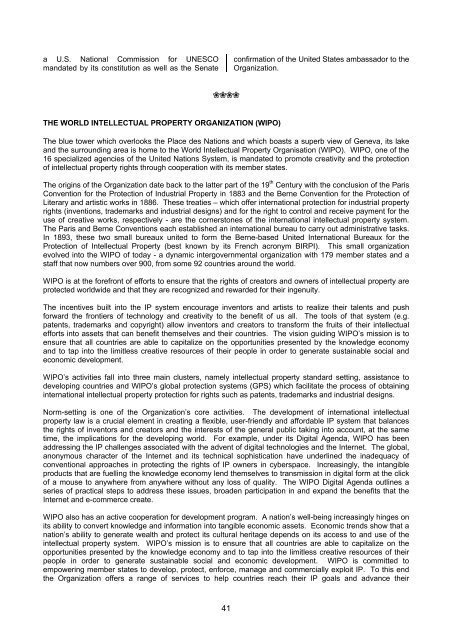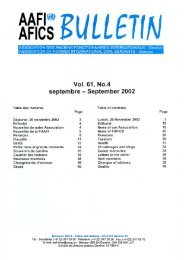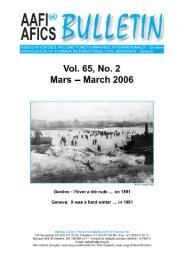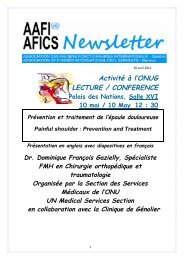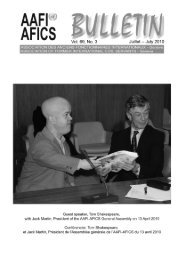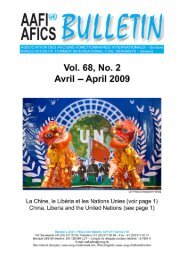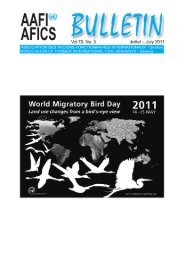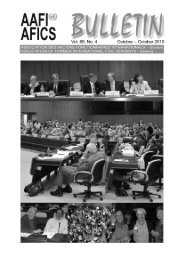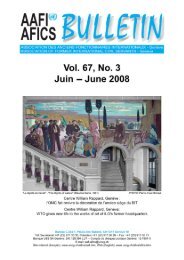nouvelles de notre association - aafi-afics - UNOG
nouvelles de notre association - aafi-afics - UNOG
nouvelles de notre association - aafi-afics - UNOG
Create successful ePaper yourself
Turn your PDF publications into a flip-book with our unique Google optimized e-Paper software.
a U.S. National Commission for UNESCO<br />
mandated by its constitution as well as the Senate<br />
confirmation of the United States ambassador to the<br />
Organization.<br />
<br />
THE WORLD INTELLECTUAL PROPERTY ORGANIZATION (WIPO)<br />
The blue tower which overlooks the Place <strong>de</strong>s Nations and which boasts a superb view of Geneva, its lake<br />
and the surrounding area is home to the World Intellectual Property Organisation (WIPO). WIPO, one of the<br />
16 specialized agencies of the United Nations System, is mandated to promote creativity and the protection<br />
of intellectual property rights through cooperation with its member states.<br />
The origins of the Organization date back to the latter part of the 19 th Century with the conclusion of the Paris<br />
Convention for the Protection of Industrial Property in 1883 and the Berne Convention for the Protection of<br />
Literary and artistic works in 1886. These treaties – which offer international protection for industrial property<br />
rights (inventions, tra<strong>de</strong>marks and industrial <strong>de</strong>signs) and for the right to control and receive payment for the<br />
use of creative works, respectively - are the cornerstones of the international intellectual property system.<br />
The Paris and Berne Conventions each established an international bureau to carry out administrative tasks.<br />
In 1893, these two small bureaux united to form the Berne-based United International Bureaux for the<br />
Protection of Intellectual Property (best known by its French acronym BIRPI). This small organization<br />
evolved into the WIPO of today - a dynamic intergovernmental organization with 179 member states and a<br />
staff that now numbers over 900, from some 92 countries around the world.<br />
WIPO is at the forefront of efforts to ensure that the rights of creators and owners of intellectual property are<br />
protected worldwi<strong>de</strong> and that they are recognized and rewar<strong>de</strong>d for their ingenuity.<br />
The incentives built into the IP system encourage inventors and artists to realize their talents and push<br />
forward the frontiers of technology and creativity to the benefit of us all. The tools of that system (e.g.<br />
patents, tra<strong>de</strong>marks and copyright) allow inventors and creators to transform the fruits of their intellectual<br />
efforts into assets that can benefit themselves and their countries. The vision guiding WIPO’s mission is to<br />
ensure that all countries are able to capitalize on the opportunities presented by the knowledge economy<br />
and to tap into the limitless creative resources of their people in or<strong>de</strong>r to generate sustainable social and<br />
economic <strong>de</strong>velopment.<br />
WIPO’s activities fall into three main clusters, namely intellectual property standard setting, assistance to<br />
<strong>de</strong>veloping countries and WIPO’s global protection systems (GPS) which facilitate the process of obtaining<br />
international intellectual property protection for rights such as patents, tra<strong>de</strong>marks and industrial <strong>de</strong>signs.<br />
Norm-setting is one of the Organization’s core activities. The <strong>de</strong>velopment of international intellectual<br />
property law is a crucial element in creating a flexible, user-friendly and affordable IP system that balances<br />
the rights of inventors and creators and the interests of the general public taking into account, at the same<br />
time, the implications for the <strong>de</strong>veloping world. For example, un<strong>de</strong>r its Digital Agenda, WIPO has been<br />
addressing the IP challenges associated with the advent of digital technologies and the Internet. The global,<br />
anonymous character of the Internet and its technical sophistication have un<strong>de</strong>rlined the ina<strong>de</strong>quacy of<br />
conventional approaches in protecting the rights of IP owners in cyberspace. Increasingly, the intangible<br />
products that are fuelling the knowledge economy lend themselves to transmission in digital form at the click<br />
of a mouse to anywhere from anywhere without any loss of quality. The WIPO Digital Agenda outlines a<br />
series of practical steps to address these issues, broa<strong>de</strong>n participation in and expand the benefits that the<br />
Internet and e-commerce create.<br />
WIPO also has an active cooperation for <strong>de</strong>velopment program. A nation’s well-being increasingly hinges on<br />
its ability to convert knowledge and information into tangible economic assets. Economic trends show that a<br />
nation’s ability to generate wealth and protect its cultural heritage <strong>de</strong>pends on its access to and use of the<br />
intellectual property system. WIPO’s mission is to ensure that all countries are able to capitalize on the<br />
opportunities presented by the knowledge economy and to tap into the limitless creative resources of their<br />
people in or<strong>de</strong>r to generate sustainable social and economic <strong>de</strong>velopment. WIPO is committed to<br />
empowering member states to <strong>de</strong>velop, protect, enforce, manage and commercially exploit IP. To this end<br />
the Organization offers a range of services to help countries reach their IP goals and advance their<br />
41


